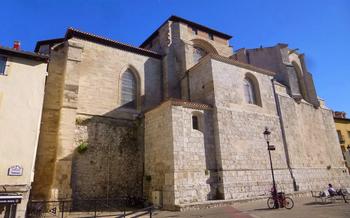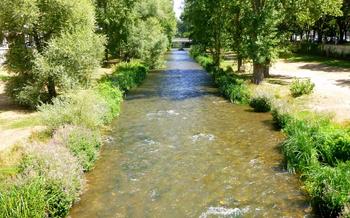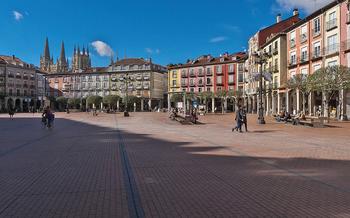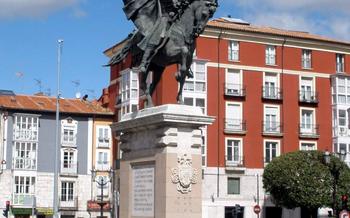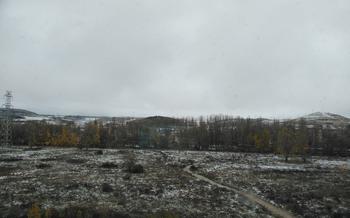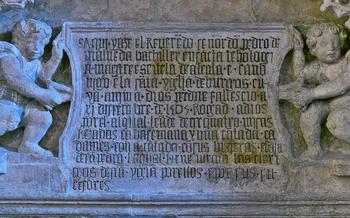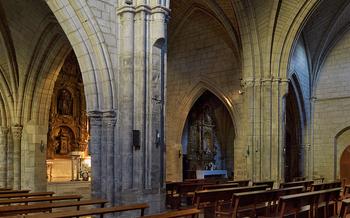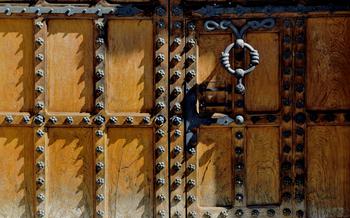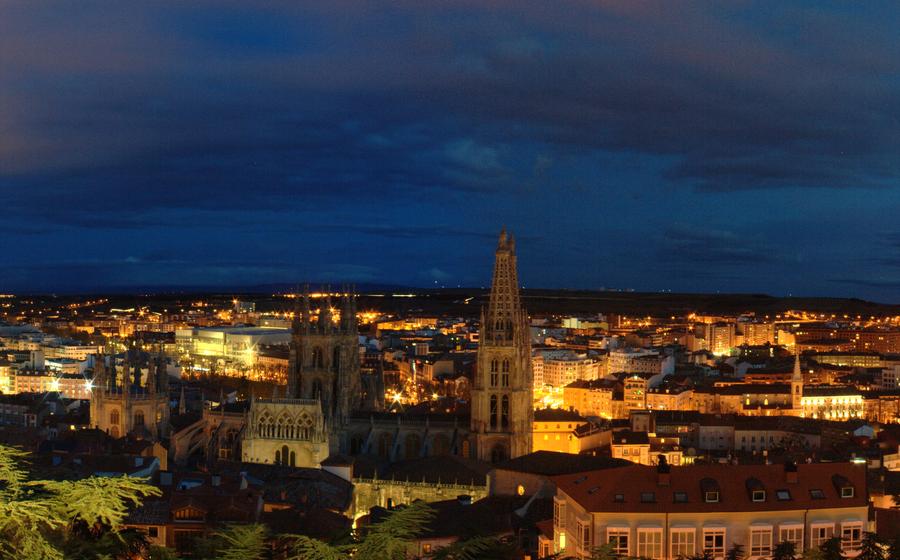
Mirador del Castillo
- History and significance of Mirador del Castillo
- Historical Roots: Unveiling the Castle's Legacy
- Exploring the Museum of Human Evolution
- Culinary Delights: A Taste of Burgos
- Artistic Treasures: The Burgos Cathedral
- A Journey into the Past: The Atapuerca Archaeological Site
- Unveiling the Art of Burgos: The Museum of Fine Arts
- Exploring the Monasteries: A Spiritual Retreat
- Nature's Haven: The Rio Ubierna Natural Park
- A Thriving Marketplace: The Plaza Mayor
- Unleash the Senses: The Wine Museum
- A Journey into the World of Wine
- Tasting the Essence of Burgos
- Educational Adventures
- Vineyard Tours and Beyond
- A Heavenly Escape: The Cartuja de Miraflores Monastery
- Step Back in Time: The Casa del Cordón
History and significance of Mirador del Castillo
The Mirador del Castillo, perched atop a hill overlooking the city of Burgos, offers breathtaking views of the surrounding landscape. Once the site of a formidable castle that played a crucial role in the city's defense, the viewpoint now stands as a testament to Burgos' rich history and cultural heritage.
Location and accessibility of the viewpoint
Situated within the Castillo de Burgos, the Mirador del Castillo can be easily reached on foot or by car. Visitors can stroll through the picturesque streets of the old town, admiring the medieval architecture and vibrant atmosphere, before ascending to the viewpoint. Alternatively, a scenic drive along the winding roads leading up to the castle offers panoramic vistas of the city and its surroundings.
The breathtaking views of Burgos from the lookout
From the Mirador del Castillo, visitors are greeted by a breathtaking panorama of Burgos and its surrounding countryside. The city's iconic landmarks, including the majestic Burgos Cathedral, the spires of the Cartuja de Miraflores Monastery, and the meandering Rio Arlanzón, are all visible from this vantage point. The rolling hills and lush greenery that envelop the city create a picturesque backdrop, making the Mirador del Castillo a popular spot for photography enthusiasts and nature lovers alike.
The cultural and historical importance of the viewpoint
The Mirador del Castillo holds immense cultural and historical significance, serving as a poignant reminder of Burgos' past. The castle that once stood on this site played a pivotal role in the city's defense and governance, withstanding numerous sieges and attacks throughout the centuries. Its strategic location allowed the castle to control access to the city and protect it from invaders. Today, the Mirador del Castillo stands as a symbol of Burgos' resilience and its rich historical legacy.
Historical Roots: Unveiling the Castle's Legacy
Burgos Castle, an imposing medieval fortress, stands as a proud symbol of the city's rich history. Its origins can be traced back to the 9th century when it was constructed as a defensive outpost against Moorish invasions. Over the centuries, the castle underwent several expansions and modifications, reflecting the evolving needs of its inhabitants.
The castle played a pivotal role in the defense and governance of Burgos. It served as a strategic stronghold during conflicts, providing protection to the city and its people. Within its walls, the castle housed military barracks, storehouses, and administrative offices, demonstrating its dual purpose as a military and administrative center.
Architecturally, Burgos Castle showcases a blend of Romanesque and Gothic styles. Its sturdy stone walls, reinforced by imposing towers, exude an aura of strength and resilience. The castle's interior reveals a labyrinth of chambers, courtyards, and passageways, each with its own unique story to tell.
Throughout its existence, Burgos Castle witnessed numerous historical events that shaped the city's destiny. It was here that King Alfonso VIII convened the Cortes of Castile in 1188, a landmark event that laid the foundation for the unification of Spain. The castle also served as a prison for illustrious figures, including the infamous Rodrigo Díaz de Vivar, known as El Cid Campeador.
Exploring the Museum of Human Evolution
Uncover the fascinating story of human evolution at the Museum of Human Evolution, a unique institution dedicated to preserving and showcasing the remarkable history of our species. Immerse yourself in interactive exhibits that bring to life the journey of our ancestors through time. Discover the secrets of our genetic heritage, the diversity of our physical characteristics, and the cultural adaptations that have enabled us to thrive as a species.
Embark on a Journey Through Time The museum's chronologically arranged exhibits guide visitors through the major milestones of human evolution, from our earliest hominid ancestors to the emergence of modern humans. Explore the fossil record, marvel at replicas of ancient skulls and skeletons, and learn about the groundbreaking discoveries that have revolutionized our understanding of our origins.
Interactive Learning Experiences The Museum of Human Evolution is not just a place to learn about evolution; it's an interactive experience that engages all the senses. Touch screens, multimedia presentations, and hands-on activities bring the exhibits to life, allowing visitors to explore the science of evolution in a fun and engaging way.
A Window into Scientific Research Beyond its exhibits, the museum is also a hub of scientific research. Its team of experts is actively involved in ongoing studies of human evolution, using cutting-edge technology to uncover new insights into our past. Visitors can learn about the latest research findings and engage with scientists who are pushing the boundaries of our knowledge.
Educational Programs and Workshops The Museum of Human Evolution is committed to promoting a deeper understanding of human evolution and its implications for our present and future. It offers a variety of educational programs and workshops tailored to different audiences, from school children to university students and lifelong learners. These programs provide hands-on learning experiences, guided tours, and interactive workshops that delve deeper into the science of human evolution.
Culinary Delights: A Taste of Burgos
Burgos is renowned for its rich and flavorful cuisine, a testament to the region's agricultural bounty. Savor the delectable Morcilla de Burgos, a unique black pudding made with pork, rice, and spices, often served grilled or fried. Indulge in Cochinillo Asado, a succulent roast suckling pig, a specialty dish in many local restaurants. For a taste of traditional stews, try Olla Podrida, a hearty casserole with chickpeas, meats, and vegetables, or Lechazo Asado, a tender roasted lamb.
Discover the local markets, where you can shop for fresh produce, artisanal cheeses, and cured meats. Attend cooking classes or workshops to learn the secrets of Burgalese cuisine and create your own culinary masterpieces. Participate in food festivals like the Concurso Nacional de Tapas or the Feria del Queso y el Vino, where you can sample a variety of regional delicacies and wines. Embark on a culinary journey through Burgos, where every bite is a celebration of the region's heritage and flavors.
Artistic Treasures: The Burgos Cathedral
The Burgos Cathedral, a masterpiece of Gothic architecture, stands as a testament to the city's rich history and cultural heritage. Its construction, spanning over several centuries, began in the 13th century, resulting in a harmonious blend of architectural styles. The cathedral's imposing facade, adorned with intricate carvings and sculptures, offers a glimpse into the artistic prowess of its creators. Inside, visitors are greeted by soaring vaulted ceilings, delicate stained-glass windows casting colorful hues, and a wealth of stunning artworks.
The cathedral boasts an impressive collection of religious artifacts and relics, including the remains of Saint John the Baptist. Its chapels, each with its distinct character, house priceless works of art, including paintings, sculptures, and goldsmithing. The Chapel of the Constable, in particular, is a masterpiece of Gothic art, showcasing intricate carvings and elaborate stained-glass windows that depict scenes from the life of Christ.
Beyond its religious significance, the Burgos Cathedral holds a profound cultural and historical value. It has witnessed countless events, from royal coronations to significant religious ceremonies, intertwining itself with the fabric of Burgos's history. Its enduring presence has made it a symbol of the city's resilience and a source of pride for its people.
A Journey into the Past: The Atapuerca Archaeological Site
The Atapuerca Archaeological Site, a UNESCO World Heritage Site, holds immense significance for human evolution. Located just 13 kilometers from Burgos, this remarkable site has yielded a treasure trove of ancient hominid fossils and tools, providing invaluable insights into our human origins.
The excavations at Atapuerca began in the 1970s and have since unearthed a wealth of evidence that has revolutionized our understanding of human evolution. Among the most notable discoveries are the remains of Homo antecessor, one of the earliest known hominid species, dating back approximately 2 million years. The site has also yielded fossils of Homo heidelbergensis, Homo neanderthalensis, and Homo sapiens, providing a comprehensive record of human evolution in the region.
Beyond the fossil discoveries, Atapuerca has also revealed a wealth of information about the behavior and lifestyle of our ancestors. The presence of stone tools, animal bones, and hearths suggests that the site was once a thriving settlement, where our ancestors hunted, gathered, and made tools.
To delve deeper into the mysteries of Atapuerca, visitors can explore the on-site museum and research center. Interactive exhibits and displays bring the site's discoveries to life, showcasing the tools, fossils, and artifacts that have been unearthed. Guided tours and educational programs provide an opportunity to learn more about the ongoing research and the significance of Atapuerca for human evolution.
A visit to the Atapuerca Archaeological Site is a journey into the past, a chance to witness firsthand the evidence of our human origins and to gain a deeper understanding of our place in the world.
Unveiling the Art of Burgos: The Museum of Fine Arts
Nestled in the heart of Burgos, the Museum of Fine Arts stands as a testament to the city's rich artistic heritage. This esteemed institution houses a treasure trove of Spanish and European masterpieces, offering visitors a captivating journey through the history of art.
The museum's permanent collection boasts an impressive array of paintings, sculptures, and decorative arts from the Middle Ages to the contemporary era. Highlights include works by renowned Spanish artists such as El Greco, Goya, and Sorolla, as well as masterpieces by European masters like Rubens, Van Dyck, and Canaletto.
Visitors can wander through the museum's elegant galleries, admiring the exquisite craftsmanship and diverse styles that adorn the walls. The collection is meticulously curated, providing a comprehensive overview of the evolution of art in Spain and beyond.
In addition to its permanent collection, the Museum of Fine Arts regularly hosts temporary exhibitions, showcasing the works of emerging and established artists, as well as thematic displays that delve into specific periods or genres. These exhibitions offer a fresh perspective on the art world, inviting visitors to engage with contemporary trends and artistic movements.
The museum also offers a range of educational programs and workshops, catering to visitors of all ages. From guided tours and lectures to hands-on art classes, these programs provide an immersive and interactive experience, fostering a deeper appreciation for the world of art and creativity.
Whether you're an art enthusiast, a history buff, or simply looking for a dose of inspiration, the Museum of Fine Arts in Burgos is an absolute must-visit. Prepare to be captivated by the beauty and diversity of the collection, as you embark on a journey through the ages, exploring the masterpieces that have shaped the artistic landscape of Spain and beyond.
Exploring the Monasteries: A Spiritual Retreat
Burgos is home to a wealth of stunning monasteries, each possessing a unique character and historical significance. These sacred havens offer a glimpse into the city's rich religious heritage and provide a serene escape from the bustling urban center.
-
The Monastery of San Pedro de Cardeña, founded in the 10th century, is a testament to Romanesque architecture. Its cloister, with its intricate carvings and serene atmosphere, is a highlight of the monastery.
-
The Monastery of Santa María la Real de Las Huelgas, established in the 12th century, was once a royal monastery and is the final resting place of several Castilian kings and queens. Its Gothic architecture and impressive collection of medieval artworks are not to be missed.
-
The Monastery of San Agustín, dating back to the 16th century, showcases a blend of Gothic and Renaissance architectural styles. Its beautifully preserved cloister and ornate altarpiece are among its most notable features.
Visiting these monasteries is an opportunity to delve into the spiritual and cultural history of Burgos. Guided tours are available, providing insights into the lives of the monks and nuns who once inhabited these hallowed grounds. Whether you seek a moment of tranquility or a deeper understanding of Burgos's religious heritage, these monasteries offer a truly enriching experience.
Nature's Haven: The Rio Ubierna Natural Park
Escape the city's hustle and bustle and immerse yourself in the tranquility of the Rio Ubierna Natural Park, a haven for nature enthusiasts and outdoor adventurers. Located just a short drive from Burgos, this sprawling park encompasses a diverse range of ecosystems, including lush forests, meandering rivers, and scenic valleys.
Explore a network of well-maintained hiking trails that wind through the park, offering breathtaking views of the surrounding landscape. As you venture deeper into the park, you'll encounter an abundance of wildlife, including red deer, wild boar, and a variety of bird species. Keep your eyes peeled for the elusive Iberian wolf, which roams the park's remote corners.
For birdwatchers, the Rio Ubierna Natural Park is a paradise. Over 200 species of birds have been recorded here, including the majestic golden eagle, the elegant black stork, and the colorful hoopoe. Bring your binoculars and spend a day observing these magnificent creatures in their natural habitat.
The park also offers opportunities for fishing, picnicking, and camping. Whether you're seeking a peaceful retreat or an adrenaline-fueled adventure, the Rio Ubierna Natural Park has something for everyone. Embrace the tranquility of nature and create lasting memories in this enchanting oasis.
A Thriving Marketplace: The Plaza Mayor
Amidst the bustling streets of Burgos, the Plaza Mayor stands as a testament to the city's rich history and vibrant culture. Once the heart of the medieval city, this grand square has witnessed countless market days, festivals, and royal proclamations. Today, it continues to be a focal point for locals and visitors alike, offering a unique blend of history, commerce, and entertainment.
The Plaza Mayor's architectural grandeur is undeniable. Surrounded by elegant Renaissance-style buildings, the square exudes an aura of timeless beauty. The most striking feature is the Casa Consistorial, the city hall, with its intricate facade adorned with intricate carvings and a majestic clock tower. Other notable buildings include the Casa del Cordón, a former palace with a fascinating history tied to Christopher Columbus, and the Teatro Principal, a neoclassical theater that hosts a variety of performances.
Beyond its architectural wonders, the Plaza Mayor is a vibrant hub of activity. Traditional markets selling local produce, artisanal crafts, and souvenirs fill the square on certain days of the week, creating a lively and colorful atmosphere. Numerous shops, cafes, and restaurants line the perimeter, offering a tempting array of culinary delights and shopping opportunities.
The Plaza Mayor is not just a place of commerce but also a venue for cultural events and festivals. Throughout the year, the square hosts concerts, art exhibitions, and traditional dances, showcasing the rich cultural heritage of Burgos. During the annual Fiesta de San Pedro y San Pablo, the city's patron saints, the Plaza Mayor transforms into a festive ground, filled with music, dancing, and joyous celebrations.
Whether you're a history buff, a shopping enthusiast, or simply seeking a vibrant atmosphere, the Plaza Mayor is a must-visit destination in Burgos. Take a leisurely stroll, soak in the architectural splendor, savor the local flavors, and immerse yourself in the infectious energy of this remarkable square.
Unleash the Senses: The Wine Museum
Nestled in the heart of Burgos, the Wine Museum is a haven for wine enthusiasts and a testament to the region's rich winemaking heritage. Embark on a journey through the centuries, discovering the history, culture, and traditions that have shaped the delectable wines of Burgos.
A Journey into the World of Wine
The museum's interactive exhibits transport visitors to the vineyards, cellars, and winemaking processes of yesteryear. Learn about the unique grape varieties that thrive in the region's climate and soil, and witness the meticulous care that goes into each bottle.
Tasting the Essence of Burgos
Indulge in guided wine tasting experiences, savoring the diverse flavors and aromas of Burgos' finest vintages. Knowledgeable sommeliers will guide you through the nuances of each wine, pairing them with local delicacies to enhance the experience.
Educational Adventures
The museum offers a range of educational programs and workshops, providing a deeper dive into the world of wine. Learn about the science behind winemaking, the art of pairing food and wine, and the history of wine in Burgos.
Vineyard Tours and Beyond
Complement your museum visit with guided tours of local vineyards and wineries. Stroll through the picturesque landscapes, meet the passionate winemakers, and witness the magic of winemaking firsthand. Experience the charm of rural Burgos and savor the flavors of its liquid gold.
A Heavenly Escape: The Cartuja de Miraflores Monastery
Nestled amidst the picturesque landscapes of Burgos, the Cartuja de Miraflores Monastery stands as a testament to the city's rich history and architectural prowess. Founded in 1442 by King Juan II of Castile, this magnificent monastery is a true masterpiece of Gothic and Renaissance architecture. Its intricate carvings, stunning stained-glass windows, and awe-inspiring frescoes leave visitors in awe.
One of the highlights of the monastery is the tomb of King Juan II and Queen Isabel of Portugal, a masterpiece of funerary art. Exquisitely crafted from alabaster, the tomb features intricate sculptures depicting the royal couple and their entourage. The attention to detail and the lifelike expressions of the figures are simply breathtaking.
Beyond its architectural splendor, the Cartuja de Miraflores Monastery holds deep cultural and religious significance. It was once home to a community of Carthusian monks, who dedicated their lives to prayer and contemplation. The monastery's peaceful ambiance and serene surroundings provide a sanctuary for visitors seeking a moment of tranquility and spiritual reflection.
Today, the Cartuja de Miraflores Monastery is open to the public as a museum. Guided tours are available, allowing visitors to delve into the history of the monastery and its inhabitants. Cultural events and exhibitions are also held throughout the year, showcasing the rich heritage of this remarkable site.
Whether you're a history buff, an architecture enthusiast, or simply seeking a spiritual retreat, the Cartuja de Miraflores Monastery is an absolute must-visit in Burgos. Its stunning beauty and historical significance make it a truly unforgettable experience.
Step Back in Time: The Casa del Cordón
Amidst the rich tapestry of Burgos' historical landmarks, the Casa del Cordón stands as a testament to the city's enduring legacy. Erected in the 15th century, this magnificent edifice boasts an intricate blend of Gothic and Renaissance architectural styles, captivating visitors with its opulent façade and rich historical significance.
Known for its distinctive stone façade adorned with the intricate "cordón" or rope motif, the Casa del Cordón served as the residence of the Constable of Castile, a powerful figure in the royal court. Its grand halls have witnessed pivotal events in Spanish history, including the signing of the Treaty of Tordesillas in 1494, which divided the newly discovered lands of the Americas between Spain and Portugal.
Step inside the Casa del Cordón and be transported back in time as you explore its elegantly preserved interiors. Admire the intricate carvings, vaulted ceilings, and stunning stained-glass windows that adorn its grand halls. The building's opulent furnishings and artwork provide a glimpse into the lavish lifestyle of the Castilian nobility during the 15th and 16th centuries.
Today, the Casa del Cordón serves as a cultural center, hosting exhibitions, concerts, and other events that celebrate Burgos' rich heritage. Visitors can embark on guided tours to uncover the fascinating stories behind this architectural gem and learn about its role in shaping the city's illustrious past.
Insider Tip: For a truly immersive experience, time your visit to coincide with one of the Casa del Cordón's special events, such as a historical reenactment or a medieval-themed banquet. These events offer a unique opportunity to step back in time and experience the grandeur of this historic mansion in all its glory.

